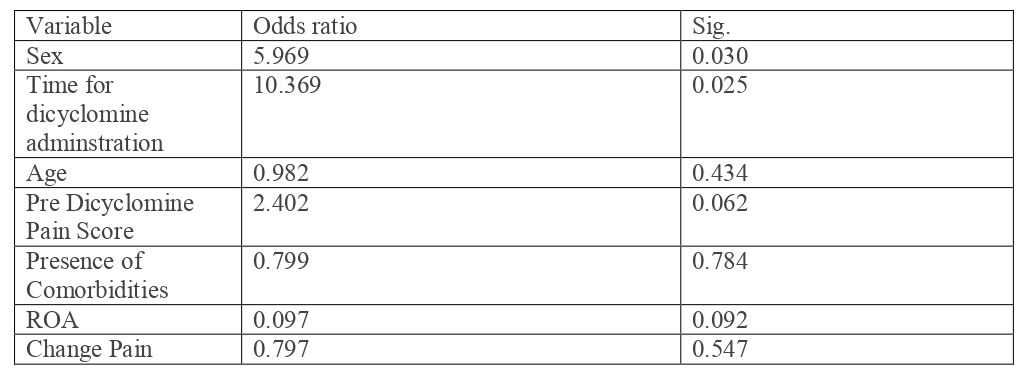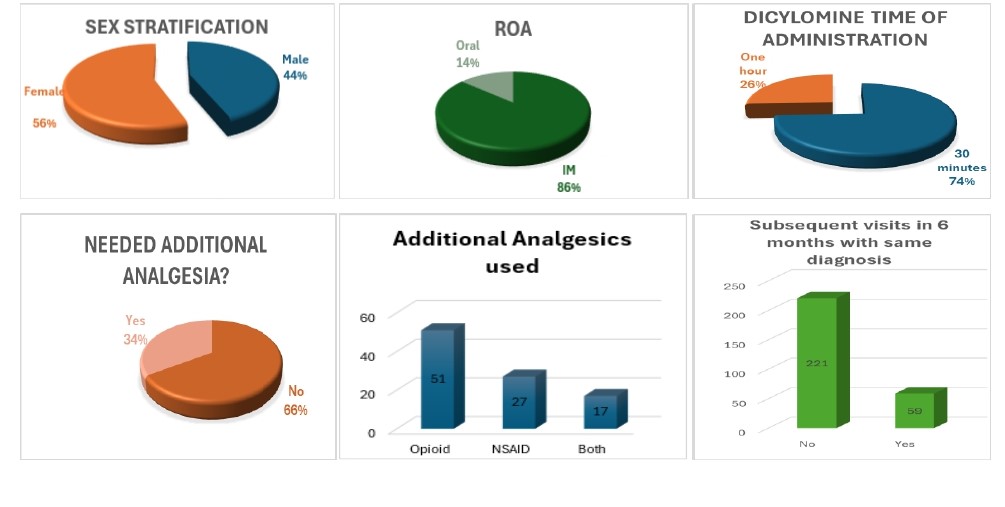Monday Poster Session
Category: Functional Bowel Disease
P2960 - The Efficacy of Dicyclomine for the Unspecified Abdominal Pain (UAP) in the Emergency Department: A Retrospective Study
Monday, October 27, 2025
10:30 AM - 4:00 PM PDT
Location: Exhibit Hall
- OU
Omer Usman, MD (he/him/his)
Texas Tech University Health Sciences Center
El Paso, TX
Presenting Author(s)
Omer Usman, MD1, Abirami Rajendiran, MD2, Azucena Del-Real, MD2, Astin Worden, MD3, Thuy-Duyen Nguyen, MD3, Deipthan Prabakar, MD2, Bansi Sutariya, MD2
1Texas Tech University Health Sciences Center, El Paso, TX; 2Paul L. Foster School of Medicine, Texas Tech University Health Sciences Center, El Paso, TX; 3Mayo Clinic, Phoenix, AZ
Introduction: Unspecified abdominal pain (UAP) refers to abdominal discomfort without an identifiable cause following initial evaluation. It is a common presentation in emergency departments (ED), where timely and effective pain management is crucial. This study examines the use of dicyclomine—a muscarinic (M1, M2, M3) receptor antagonist and non-competitive inhibitor of histamine and bradykinin, commonly used for intestinal spasms in functional bowel disorders and irritable bowel syndrome (IBS)—for early pain relief in patients with UAP in the ED setting.
Methods: We conducted a retrospective chart review of ED visits from January 1, 2019, to November 1, 2024. Patients included were non-pregnant adults (age >18 years) with a first-time diagnosis of UAP (ICD-10 code R10.9), who received dicyclomine and had complete pre- and post-treatment pain scores along with demographic and clinical data. Out of 3,517 identified cases, 280 met inclusion criteria. Patients with incomplete records or identifiable organic causes were excluded. The primary outcome was the need for additional analgesia following dicyclomine administration.
Results: The study included 280 patients with a median age of 40.7 ± 16.8 years; 55.7% were female. First-time ED presentation for UAP occurred in 57.1% (160), and 55.7% (156) had no known comorbidities. Dicyclomine was administered within 30 minutes of physician evaluation in 74.3% (208) of cases, and within 1 hour in 25.7% (72). Administration routes were oral in 13.9% (39) and intramuscular in 86.1% (241). The majority received a 20 mg dose (98.6%). Mean pain scores significantly decreased from 7.65 ± 1.57 to 2.45 ± 1.41 post-dicyclomine, with a mean reduction of 5.2 ± 1.77 (t = 49.1, df = 279, p < 0.001). Binary logistic regression identified female sex (OR = 5.97, p < 0.05) and delayed drug administration ( >60 minutes) (OR = 10.3, p < 0.05) as significant predictors of requiring additional analgesia. Of the total, 66.1% (185) did not require additional analgesia, while 33.9% (95) did. Among these, 18.2% (51) received opioids, 9.6% (27) NSAIDs, and 6.1% (17) both. Overall, 99.6% (279) of patients were discharged home from the ED.
Discussion: Although evidence on the use of dicyclomine for UAP is limited, our findings suggest that it may be an effective initial analgesic option in the ED, particularly for younger patients without comorbidities. Prompt administration appears to improve outcomes and reduce the need for additional analgesics, especially opioids.

Figure: Binary Logistic Regression Analysis of Predictors for Additional Analgesia Requirement

Figure: Composite Visualization of Clinical and Treatment Variables in Patients
Disclosures:
Omer Usman indicated no relevant financial relationships.
Abirami Rajendiran indicated no relevant financial relationships.
Azucena Del-Real indicated no relevant financial relationships.
Astin Worden indicated no relevant financial relationships.
Thuy-Duyen Nguyen indicated no relevant financial relationships.
Deipthan Prabakar indicated no relevant financial relationships.
Bansi Sutariya indicated no relevant financial relationships.
Omer Usman, MD1, Abirami Rajendiran, MD2, Azucena Del-Real, MD2, Astin Worden, MD3, Thuy-Duyen Nguyen, MD3, Deipthan Prabakar, MD2, Bansi Sutariya, MD2. P2960 - The Efficacy of Dicyclomine for the Unspecified Abdominal Pain (UAP) in the Emergency Department: A Retrospective Study, ACG 2025 Annual Scientific Meeting Abstracts. Phoenix, AZ: American College of Gastroenterology.
1Texas Tech University Health Sciences Center, El Paso, TX; 2Paul L. Foster School of Medicine, Texas Tech University Health Sciences Center, El Paso, TX; 3Mayo Clinic, Phoenix, AZ
Introduction: Unspecified abdominal pain (UAP) refers to abdominal discomfort without an identifiable cause following initial evaluation. It is a common presentation in emergency departments (ED), where timely and effective pain management is crucial. This study examines the use of dicyclomine—a muscarinic (M1, M2, M3) receptor antagonist and non-competitive inhibitor of histamine and bradykinin, commonly used for intestinal spasms in functional bowel disorders and irritable bowel syndrome (IBS)—for early pain relief in patients with UAP in the ED setting.
Methods: We conducted a retrospective chart review of ED visits from January 1, 2019, to November 1, 2024. Patients included were non-pregnant adults (age >18 years) with a first-time diagnosis of UAP (ICD-10 code R10.9), who received dicyclomine and had complete pre- and post-treatment pain scores along with demographic and clinical data. Out of 3,517 identified cases, 280 met inclusion criteria. Patients with incomplete records or identifiable organic causes were excluded. The primary outcome was the need for additional analgesia following dicyclomine administration.
Results: The study included 280 patients with a median age of 40.7 ± 16.8 years; 55.7% were female. First-time ED presentation for UAP occurred in 57.1% (160), and 55.7% (156) had no known comorbidities. Dicyclomine was administered within 30 minutes of physician evaluation in 74.3% (208) of cases, and within 1 hour in 25.7% (72). Administration routes were oral in 13.9% (39) and intramuscular in 86.1% (241). The majority received a 20 mg dose (98.6%). Mean pain scores significantly decreased from 7.65 ± 1.57 to 2.45 ± 1.41 post-dicyclomine, with a mean reduction of 5.2 ± 1.77 (t = 49.1, df = 279, p < 0.001). Binary logistic regression identified female sex (OR = 5.97, p < 0.05) and delayed drug administration ( >60 minutes) (OR = 10.3, p < 0.05) as significant predictors of requiring additional analgesia. Of the total, 66.1% (185) did not require additional analgesia, while 33.9% (95) did. Among these, 18.2% (51) received opioids, 9.6% (27) NSAIDs, and 6.1% (17) both. Overall, 99.6% (279) of patients were discharged home from the ED.
Discussion: Although evidence on the use of dicyclomine for UAP is limited, our findings suggest that it may be an effective initial analgesic option in the ED, particularly for younger patients without comorbidities. Prompt administration appears to improve outcomes and reduce the need for additional analgesics, especially opioids.

Figure: Binary Logistic Regression Analysis of Predictors for Additional Analgesia Requirement

Figure: Composite Visualization of Clinical and Treatment Variables in Patients
Disclosures:
Omer Usman indicated no relevant financial relationships.
Abirami Rajendiran indicated no relevant financial relationships.
Azucena Del-Real indicated no relevant financial relationships.
Astin Worden indicated no relevant financial relationships.
Thuy-Duyen Nguyen indicated no relevant financial relationships.
Deipthan Prabakar indicated no relevant financial relationships.
Bansi Sutariya indicated no relevant financial relationships.
Omer Usman, MD1, Abirami Rajendiran, MD2, Azucena Del-Real, MD2, Astin Worden, MD3, Thuy-Duyen Nguyen, MD3, Deipthan Prabakar, MD2, Bansi Sutariya, MD2. P2960 - The Efficacy of Dicyclomine for the Unspecified Abdominal Pain (UAP) in the Emergency Department: A Retrospective Study, ACG 2025 Annual Scientific Meeting Abstracts. Phoenix, AZ: American College of Gastroenterology.
